

Above is the Corinthian black-figure amphora with animal friezes dating back to 625-600 B.C. It is approimately 14" high. The amphora was found on the island of Rhodes at the opposite side of the Agaean mainland CorinthIt is organized in the old Geometric style organized in a series of horizontal bands. On the neck has many animals and other composite creatures. It is a black-figure pot. The black stuff is neither a pigment nor a glaze, but engobe, a slip of finely sifted clay that originally is of the same color as the clay of the pot. It becomes black after being fired in three phases.

Pictured on the right is Lady of Auxere, statue of a goddess or kore. Her right hand is placed on her chest as a gesture of prayer. Despite its monumental quality, the statue is a little over two feet tall. It is dated back to 650-625 B.C. She is the masterpiece of a style which is usually referred to as Daedalic. Characteristic of the style is the triangular flat-topped head framed by long strands of hair that form complementary triangles to that of the face.Also characteristic is the small belted waist and a fondness for pattern: note the almost Geometric treatment of the long skirt with its incised concentric squares, once brightly painted.
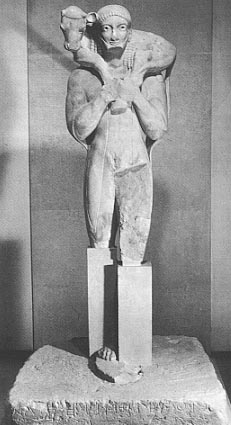
Pictured above is the Calf-bearer (Moschophoros)dating back to 560 B.C. It is carved from marble and stands at roughly five feet and five inches. It was found in fragments at the Athenian Acropolis. He stands in the left-foot forward manner of the kouroi, but he is bearded so he is no longer a youth. He is Archaic, as evidenced by that infamous Archaic smile. The bodies of the man and the calf are also unified by a bold X that is formed by the calf's legs and the calf-bearer's arms.
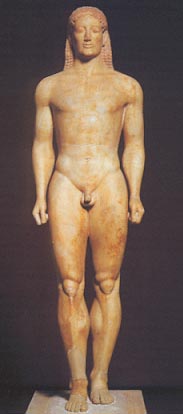
Shown above is Kroisos. It is from Anavyos and dates back to 530 B.C. Carved from marble, it stands at approximately six feet and four inches tall. It too is Archaic but is also very rigid and frontal. Originally it was painted in the durable technique of encaustic, in which pigment is mixed with wax and applied to the surface while hot.
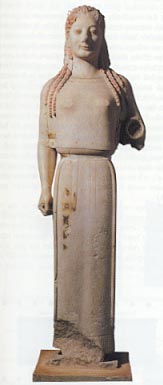
A stylistic "sister" to the Kroisos kouros is the Peplos Kore (shown above.) She wears a peplos, a simple long woolen belted garment that gives the female figure a columnar appearance. It has traces of paint on it which means that it was once painted. A change did occur here though; her left arm is broken off because it was once extended out in front of her---a radical change from the once frontal stance of earlier Archaic statues.
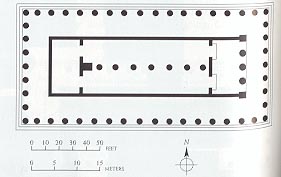
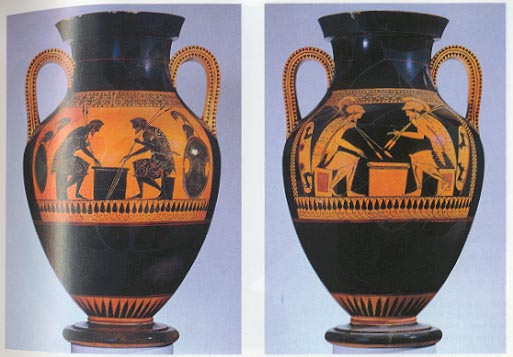
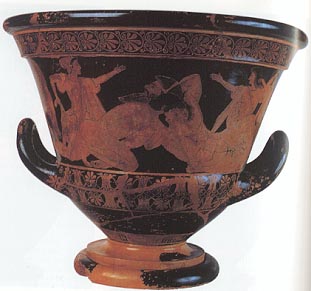
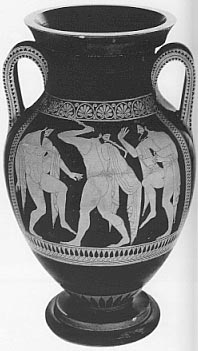
Pictured above is "Three Revelers" by Euthymides. It too is a red-figure amphora. It is from Vulci and dates back to 510 B.C. Because Euthymides disagreed with old conventions of formality and frontality, he has drawn the three tipsy revelers with overlap. They are foreshortened, that is, shown in a 3/4 view.
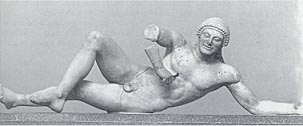
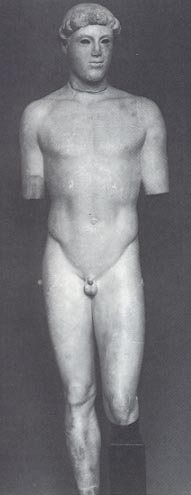
This is the Kritios Boy from the Acropolis, Athens. He is 34" tall and dates back to 480 B.C., the Classical period of Greece. He is the embodiment of the Greek idealization of the body. The body was very important to the Greeks. This is a transitional piece. It is the first with evidence of contrapposto, that is, the realistic shift in the hips when someone stands with their leg extended.
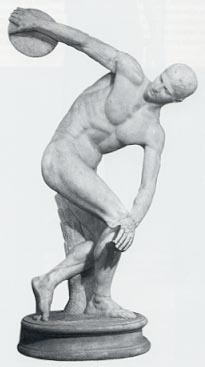
Above is Diskobolos (Discus thrower.) It is actually a Roman marble copy. (We know because it has to be supported by that tree stump.) It was sculpted by Myron and dates back to 450 B.C.. It is 5'1". It is significantly different from all the previous sculptures because there is a lot of movement. A man is shown (in the nude, of course) getting ready to throw a discus. His body is very idealized too and he seems almost too perfect.
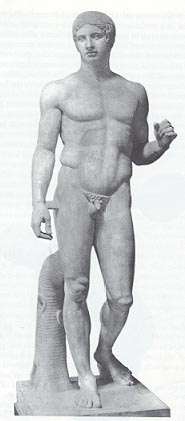
This is Doryphoros (Spear-bearer) sculpted by Polykleitos. The one shown here is a Roman marble copy. Polykleitos is famous for his so-called "canon of proportion." He used mathematical formulas to create ideal human bodies.
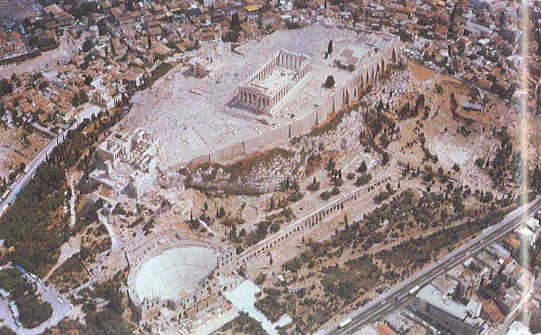
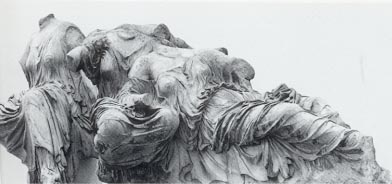
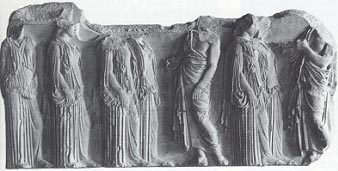
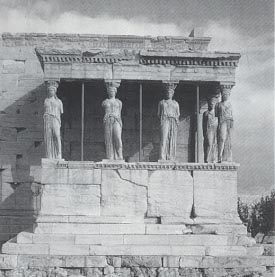
Pictures above is the South porch of the Erechteion. One of the most striking and famous features of the temple is its South porch because as you can see, caryatids replace Ionic columns. The role of the caryatids as architectural supports for the unusual flat roof above is underscored by the vertical flute-like folds of the drapery concealing their stiff weight-bearing legs.
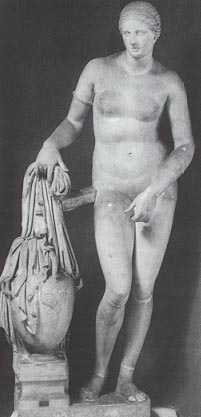
This is the "Aphrodite of Knidos" by Praxiteles. The one shown here is actually a Roman marble copy after the original which dates back to 350-340 B.C. It stands at approximately 6'8" high. Aphrodite is shown engaged in a trivial act of everyday life. The goddess has removed her garments, modestly shielding her pelvis as she gets ready to step into the bath. It caused a sensation in its time because of the fact that Praxiteles had taken the unprecedented step of representing the goddess of love completely in the nude. Female nudity in early Greek art, shown here, is extremely rare.
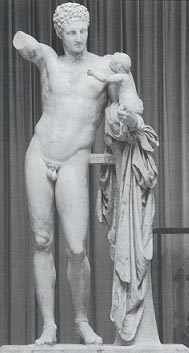
Shown above is "Hermes and the infant Dionysos" by Praxiteles from Olympia. It was found in the Temple of Hera at Olympia. In this piece Hermes has stopped to rest in a forest. He leans on a tree trunk and his slender body forms a sinuous, shallow S-curve that is the hallmark of many of Praxiteles's statues. The one shown here is a Roman Marble copy though, as evidenced by the support of the tree trunk.
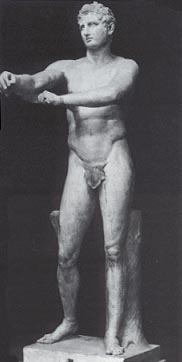
Shown here is "Apoxyomenos" (scraper.) This one is a Roman Marble copy. He is supported by a tree trunk as well and his, as Mr. Papciak would say, "tallywacker", is covered by a leaf. he original was created by Lysippos who created a new canon of proportion in which bodies were more slender than those of Polykleitos.
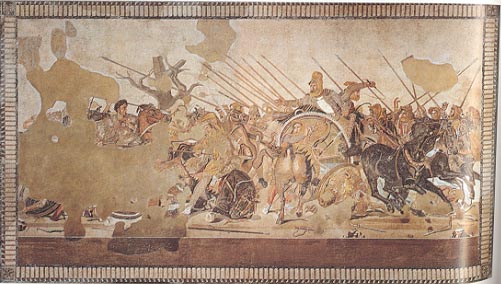
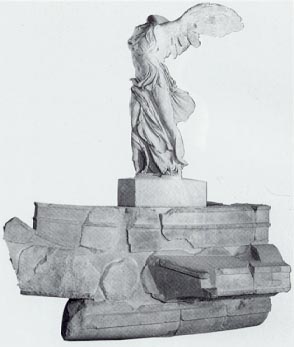
This is the beautiful and innovative "Nike of Samothrace", dating back to 190 B.C. It comes from the Hellenistic period which is characterized by emotional intensity. The marble statue was set up in the Sanctuary of the Great Gods on the island of Samothrace. Her wings are still beating and her drapery is swept by the wind. It also has that wet look and there is evidence of a body under those clothes. She was at the center of a fountain.
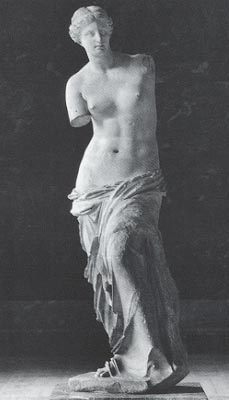
This is the famous "Venus de Milo", an over-life-size marble statue of Aphrodite found on Melos. It was sculpted by Alexandros of Antioch-on-the-Meander. The goddess of love is more modestly draped, but also more overtly sexual. The sculptor meant to tease the spectator. It is far more sexual than Praxiteles's entirely nude image of the goddess (Aphrodite of Knidos.)
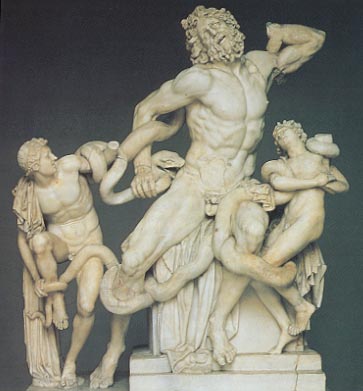
Also from the Hellenistic period is this sculpture shown here. It is called "Laocoon and his sons" by Athanadoros, Hagesandros and Polydoros of Rhodes. Characteristic of the Hellenistic style, this piece explodes with emotional intensity as Laocoon and his sons are attacked by sea serpents. The serpents had been sent by the gods who favored the Greeks in the war against Troy tp punish Laocoon who tried to warn his countrymen about the danger of bringing the Greeks' Wooden Horse into the walls of their city.